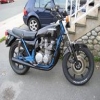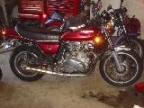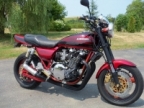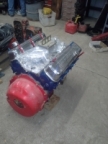Break in new cylinder, pistons & rings
- bountyhunter
-

- Offline
- User
-

Registered
- Posts: 7245
- Thanks: 338
Re: Break in new cylinder, pistons & rings
04 Apr 2008 11:44
steell wrote:
And another good one.
An engine's initial run should be used to bring oil and coolant (air, oil, and/or water) up to operating temperature only, with little or no load, then shut down and allowed to cool to ambient temperature. This is important. After each run the engine needs to completely cool down to ambient temperature. In Texas, especially in the summer, that's still pretty hot. After a cool down period, start it up again and take the motorcycle for it's fist ride (you hope).
This time give the engine light loads at relatively low rpm and stay out of top gear. Lugging the engine, i.e., low RPM with a lot of throttle (manifold pressure), is more detrimental than high rpm. Another key is too constantly vary engine load during the entire break-in period. A constant load is not ideal for breaking in bearing tolerances. This second run should last only 10-15 minutes before another complete cool down.
The third run should see slightly higher rpm with light to medium power loading using short bursts of acceleration to help seat the rings. Again 10-15 minutes of running should do it and again avoid top gear. A forth run should consist of light to medium engine loads with a few more bursts of medium-high rpm, and lasting just 10-15 minutes varying the engine load and again avoiding top gear. Next while the engine is still warm drain the oil and change the filter. This gets out the new metal particles that are being worn away. Most of the metal particles will break away within the first 50 -75 miles. To ensure the rings seat well, use the same high quality oil and don't be shy about short duration high rpm blasts through the lower gears after the oil has been changed.
A few more 15-20 minute sessions should be used to work up to the engine's redline gradually increasing the engine loads.
That procedure is more complicated than the final check to launch the space shuttle.:laugh:
1979 KZ-750 Twin
Please Log in or Create an account to join the conversation.
- 77_650B1
-

- Offline
- User
-

Registered
- Posts: 372
- Thanks: 0
Re: Break in new cylinder, pistons & rings
04 Apr 2008 12:30 - 04 Apr 2008 12:31
lol, for sure Nasa is almost that picky.
but yeah, just drive it, varying your rpm's, make sure its warmed up before you go, go slowly at first and increase load as you put more miles on it. use dinosaur oil too if you think that'll help, i'm sure synthetics wont kill your engine. i use dino oil all the time anyhow, because its cheap and these old engines were designed with it in mind.
but yeah, just drive it, varying your rpm's, make sure its warmed up before you go, go slowly at first and increase load as you put more miles on it. use dinosaur oil too if you think that'll help, i'm sure synthetics wont kill your engine. i use dino oil all the time anyhow, because its cheap and these old engines were designed with it in mind.
1977 KZ650-B1
-Dual Discs
-Dyna-S
-WG Coil Mod
-Alloy Wheels
-Dual Discs
-Dyna-S
-WG Coil Mod
-Alloy Wheels
Last edit: 04 Apr 2008 12:31 by 77_650B1.
Please Log in or Create an account to join the conversation.
- steell
-

- Offline
- User
-

Registered
- Posts: 6849
- Thanks: 208
Re: Break in new cylinder, pistons & rings
04 Apr 2008 18:55 - 04 Apr 2008 18:56
bountyhunter wrote:
steell wrote:And another good one.
FWIW, the consensus of what I have read relegates that one into urban myth category. The advantage (or difference) of synthetic oil is not it's "slipperyness", it is that it's viscosity is very constant and stands up to heat very well, also it doesn't break down as readily from shearing.Use high quality, low viscosity oil (Valvoline 30 weight), no synthetics, too slippery. If synthetics are used during initial break in the rings are sure to glaze over.
.
Some makers of very high end cars not only use synthetic in the new engine, they call it out for use.
YMMV
Porsche and Corvette motors have synthetic in them from the start, and I'm sure there are more.
Hey!! I didn't say they were absolutely correct, I just said they were reasonable!!
:laugh: :laugh: :laugh: :laugh: :laugh: :laugh: :laugh: :laugh:
KD9JUR
Last edit: 04 Apr 2008 18:56 by steell.
Please Log in or Create an account to join the conversation.
- mark1122
-

- Offline
- User
-

Registered
- Keep twisting it
- Posts: 5359
- Thanks: 109
Re: Break in new cylinder, pistons & rings
06 Apr 2008 09:58
some of the best drag racers assemble the pistons dry. no oil on the rings and cyl.this makes the rings seat right away. not saying this is the best way. just that it can be done and this is how i will seat mine.
id like to know more about synthetic oil. with my 1327cc i am concerned with heat and i have read that some dino oils break down at 230*.syn may be better after break in.
id like to know more about synthetic oil. with my 1327cc i am concerned with heat and i have read that some dino oils break down at 230*.syn may be better after break in.
76 KZ, frame gusset work,1200CC.Ported by Larry Cavanaugh, 1.5mm.over intakes, Carron Pipe, ZRX12 rear end, and seat,96zx9 front end.
01 CBR600F4i Track bike.
Cobourg, Ont. Can.
~ ~ ~_@
~ ~ _- \,
~ (k) / (z)
01 CBR600F4i Track bike.
Cobourg, Ont. Can.
~ ~ ~_@
~ ~ _- \,
~ (k) / (z)
Please Log in or Create an account to join the conversation.
- mark1122
-

- Offline
- User
-

Registered
- Keep twisting it
- Posts: 5359
- Thanks: 109
Re: Break in new cylinder, pistons & rings
06 Apr 2008 10:05
1 more thing. i would prime the oil pump 1st. pore oil into the oil passage ,under the oil preasure switch , till full.just to give the oil a head start for the first start up.anyone have any good info on this.
76 KZ, frame gusset work,1200CC.Ported by Larry Cavanaugh, 1.5mm.over intakes, Carron Pipe, ZRX12 rear end, and seat,96zx9 front end.
01 CBR600F4i Track bike.
Cobourg, Ont. Can.
~ ~ ~_@
~ ~ _- \,
~ (k) / (z)
01 CBR600F4i Track bike.
Cobourg, Ont. Can.
~ ~ ~_@
~ ~ _- \,
~ (k) / (z)
Please Log in or Create an account to join the conversation.
- bountyhunter
-

- Offline
- User
-

Registered
- Posts: 7245
- Thanks: 338
Re: Break in new cylinder, pistons & rings
06 Apr 2008 12:32
mark1122 wrote:
Your advice was good info. I f you have the pump off the engine, you refill it afer re assembly (how to is in the manual).
If the engine top was rebuilt, the smart mony is to leave the spark plugs out and crank the engine over on the starter for a while to get oil up. If you are really macho, you can use the kick starter.:laugh:
Definitely want the oil up and flowing before you fire up a new engine.
1 more thing. i would prime the oil pump 1st. pore oil into the oil passage ,under the oil preasure switch , till full.just to give the oil a head start for the first start up.anyone have any good info on this.
Your advice was good info. I f you have the pump off the engine, you refill it afer re assembly (how to is in the manual).
If the engine top was rebuilt, the smart mony is to leave the spark plugs out and crank the engine over on the starter for a while to get oil up. If you are really macho, you can use the kick starter.:laugh:
Definitely want the oil up and flowing before you fire up a new engine.
1979 KZ-750 Twin
Please Log in or Create an account to join the conversation.
- 77_650B1
-

- Offline
- User
-

Registered
- Posts: 372
- Thanks: 0
Re: Break in new cylinder, pistons & rings
06 Apr 2008 13:05
Or just use lots of assembly lube...like yer sposed to.
1977 KZ650-B1
-Dual Discs
-Dyna-S
-WG Coil Mod
-Alloy Wheels
-Dual Discs
-Dyna-S
-WG Coil Mod
-Alloy Wheels
Please Log in or Create an account to join the conversation.
- nads.com
-
- Offline
- User
-

Registered
- Posts: 995
- Thanks: 20
Re: Break in new cylinder, pistons & rings
06 Apr 2008 16:01
steell wrote:
And another good one.
Most people seem to operate on the philosophy that they can best get their money's worth from any mechanical device by treating it with great care. This is probably true, but in many cases it is necessary to interpret what great care really means. This is particularly applicable when considering the break-in of a modern, reciprocating engine.
For those who still think that running the engine hard during break-in falls into the category of cruel and unusual punishment, there is one more argument for using high power loading for short periods (to avoid excessive heat) during the break-in. The use of low power settings does not expand the piston rings enough, and a film of oil is left on the cylinder walls. The high temperatures in the combustion chamber will oxidize this oil film so that it creates glazing of the cylinder walls. When this happens, the ring break-in process stops, and excessive oil consumption frequently occurs. The bad news is that extensive glazing can only be corrected by removing the cylinders and rehoning the walls. This is expensive, and it is an expense that can be avoided by proper break in procedures.
We must achieve a happy medium where we are pushing on the ring hard enough to wear it in but not hard enough to generate enough heat to cause glazing. Once again, if glazing should occur, the only remedy is to remove the effected cylinder, re-hone it and replace the piston rings and start the whole process over again.
We asked four top motorcycle engine builders what they do to ensure peak power output and optimum engine life. Here is a capsulation of their responses.
"If the wrong type of oil is used initially, or the break-in is too easy, rings and cylinders could (read will) glaze and never seal properly. A fresh cylinder wall needs some medium to high engine loading to get the piston rings to seat properly for good compression but make sure you don't lug or overheat the engine. Use high quality, low viscosity oil (Valvoline 30 weight), no synthetics, too slippery. If synthetics are used during initial break in the rings are sure to glaze over.
An engine's initial run should be used to bring oil and coolant (air, oil, and/or water) up to operating temperature only, with little or no load, then shut down and allowed to cool to ambient temperature. This is important. After each run the engine needs to completely cool down to ambient temperature. In Texas, especially in the summer, that's still pretty hot. After a cool down period, start it up again and take the motorcycle for it's fist ride (you hope).
This time give the engine light loads at relatively low rpm and stay out of top gear. Lugging the engine, i.e., low RPM with a lot of throttle (manifold pressure), is more detrimental than high rpm. Another key is too constantly vary engine load during the entire break-in period. A constant load is not ideal for breaking in bearing tolerances. This second run should last only 10-15 minutes before another complete cool down.
The third run should see slightly higher rpm with light to medium power loading using short bursts of acceleration to help seat the rings. Again 10-15 minutes of running should do it and again avoid top gear. A forth run should consist of light to medium engine loads with a few more bursts of medium-high rpm, and lasting just 10-15 minutes varying the engine load and again avoiding top gear. Next while the engine is still warm drain the oil and change the filter. This gets out the new metal particles that are being worn away. Most of the metal particles will break away within the first 50 -75 miles. To ensure the rings seat well, use the same high quality oil and don't be shy about short duration high rpm blasts through the lower gears after the oil has been changed.
A few more 15-20 minute sessions should be used to work up to the engine's redline gradually increasing the engine loads. After some definite hard running and 250-500 miles it's a good idea to check the valves. After 500 miles re-torqueing the head is suggested. Switch to synthetic oil but not before 500-1500 miles. Most of the engine experts warned of the danger of breaking in the engine too easily and ending up with an engine that will always run slow whether it is from tight tolerances, inadequate ring seal or carbon buildup. Engine load is more detrimental than rpm because of the head created internally, so avoid lugging the engine but rev it freely especially in the lower gears. Basically, be sure not to get it too hot but be sure to seat the rings properly.
So that's it, sure a lot different than keeping under 4000 rpm for 500 miles then under 5000 rpm for 1000 miles. Maybe bike manufacturers are being super cautious at the expense of your motor's performance? I think that they take the cautious route that works over time (1000 miles, or about 20 hours of break in) versus a faster route that can be more easily screwed up."
www.ntnoa.org/enginebreakin.htm
Think that break in procedure exceeds most peoples common sense capacity and life expectantcy. NOt too hot, not tooo cold not to high not to low, LOL!:huh:
.
Please Log in or Create an account to join the conversation.
- bountyhunter
-

- Offline
- User
-

Registered
- Posts: 7245
- Thanks: 338
Re: Break in new cylinder, pistons & rings
07 Apr 2008 09:33
nads.com wrote:
I'm with you on that. I have two engineering degrees and reading it gave me a headache. When I first got my 750 twin brand new back in '79, all I did was ride it. It never burned a drop of oil for the whole 30 years I've owned it, changed the oil every 3k and never had to add oil between changes.
steell wrote:
Think that break in procedure exceeds most peoples common sense capacity and life expectantcy. NOt too hot, not tooo cold not to high not to low, LOL!:huh:
.
I'm with you on that. I have two engineering degrees and reading it gave me a headache. When I first got my 750 twin brand new back in '79, all I did was ride it. It never burned a drop of oil for the whole 30 years I've owned it, changed the oil every 3k and never had to add oil between changes.
1979 KZ-750 Twin
Please Log in or Create an account to join the conversation.
- PLUMMEN
-

- Offline
- User
-

Registered
- Posts: 7986
- Thanks: 104
Re: Break in new cylinder, pistons & rings
07 Apr 2008 10:06
bountyhunter wrote:
steell wrote:try cleaning synthetic oil out of the nooks and crannys of a kawasaki crank before welding the pins,ive had a little experiance with that.:laugh: synthetic oil lubricates a whole lot better than any old bones ive used ,ive seen a couple smallblock chevys with 400,000(yes 400)miles that till had the cross hatch in the cylinder walls from running synthetic oil starting after the breakin periodB)And another good one.
FWIW, the consensus of what I have read relegates that one into urban myth category. The advantage (or difference) of synthetic oil is not it's "slipperyness", it is that it's viscosity is very constant and stands up to heat very well, also it doesn't break down as readily from shearing.Use high quality, low viscosity oil (Valvoline 30 weight), no synthetics, too slippery. If synthetics are used during initial break in the rings are sure to glaze over.
.
Some makers of very high end cars not only use synthetic in the new engine, they call it out for use.
YMMV
Still recovering,some days are better than others.
Please Log in or Create an account to join the conversation.
Moderators: Street Fighter LTD

